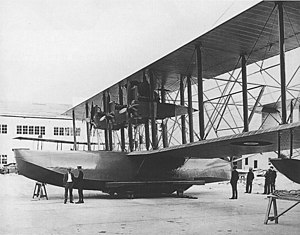Curtiss NC
| Curtiss NC | |
|---|---|
 |
|
| "NC-1" after completion, in three-engine configuration, 3 October 1918. | |
| Role | Long-range patrol |
| National origin | United States |
| Manufacturer | Curtiss Aeroplane and Motor Company |
| First flight | 4 October 1918 |
| Primary user | United States Navy |
| Number built | 10 |
| Variants | NC-4 |
The Curtiss NC (Curtiss Navy Curtiss, nicknamed "Nancy boat" or "Nancy") was a flying boat built by Curtiss Aeroplane and Motor Company and used by the United States Navy from 1918 through the early 1920s. Ten of these aircraft were built, the most famous of which is the NC-4, the first airplane to make a transatlantic flight. The NC-4 is preserved in the National Museum of Naval Aviation, at NAS Pensacola, Florida.
Manufacture of the "NC"s began in 1918 during World War I. The U.S. Navy wished for an aircraft capable of long ocean flights, both for Anti-submarine warfare patrol, and if possible with capability to fly across the Atlantic Ocean under their own power to avoid having to be shipped through ocean waters menaced by German submarines. This was a very ambitious undertaking, given the state of aviation at the time. The Navy and Curtiss came up with one of the largest biplane designs yet produced, equipped with sleeping quarters and a wireless transmitter/receiver. It was originally powered by three V12 Liberty engines, of 400 hp (298 kW) each; during the testing phase Marc Mitscher recommended the addition of a fourth engine to help create enough power to lift the boats out of the water. The fourth engine was added to the midline in a pusher configuration. The maximum speed was 90 mph (144 km/h) and the estimated maximum range was 1,500 mi (2,400 km). Called NC boats, with the "N" for Navy and "C" for the builder Curtiss, they were nicknamed "Nancys".
...
Wikipedia
